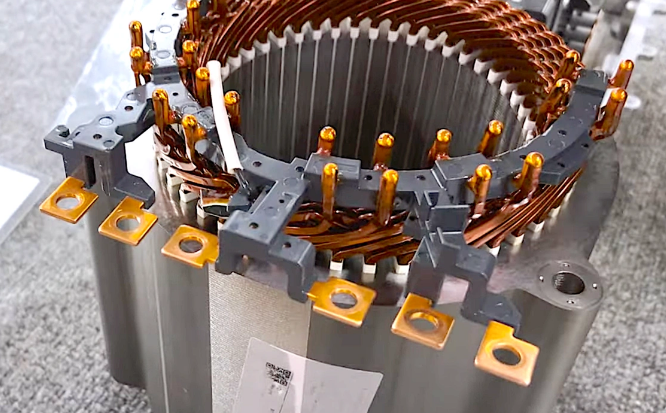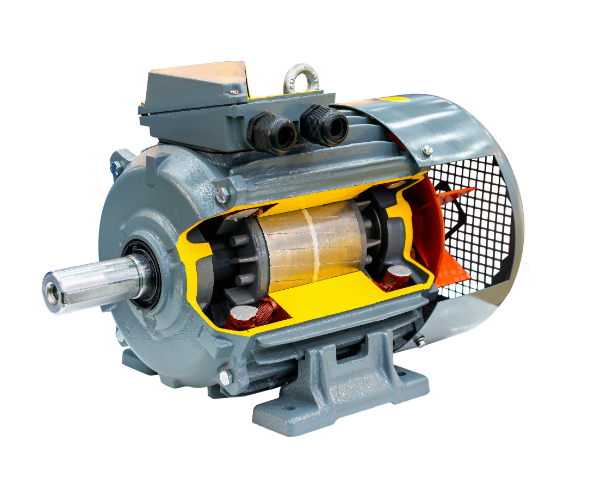Three-phase motors used in underwater pump equipment have features of high power, efficiency, stability, and durability but come with higher costs. For instance, the efficiency of three-phase motors can go up to over 90%, a vast improvement over the nearly 70% achieved by single-phase motors, while lasting up to 20% longer. If the duration of operation is 10 hours per day, three-phase motors can save 10%-15% more in power consumption than single-phase motors over a year for water pump systems. In terms of usability, three-phase motors have high starting torque and operate stably, making them suitable for water pump systems that stop frequently; even in harsh environments, they can effectively reduce the failure rate by 40%.
High Efficiency and Stability
Water pump systems are often a significant part of the costs incurred by enterprises with large-scale pump stations in long-term operation (e.g., industrial water supply, agricultural irrigation, or sewage treatment). Compared with single-phase motors, the energy conversion efficiency of three-phase motors is mostly higher than 90%, which is significantly better than the previous 70%. Three-phase motors have a superior energy efficiency ratio, which can not only reduce the consumption of electricity in water pump systems but also lengthen the service life and avoid unexpected breakdowns during operational use.
A 7.5 kW water pump running for eight hours a day installed with a three-phase motor will save nearly 10% of the cost of electricity in one year. Assuming the electricity cost is 0.7 RMB per kWh, this water pump system can save over 1,500 RMB in electricity bills in one year. Consequently, this energy-saving effect is even more substantial for municipal water supply systems, since they have to work 24 hours a day.
Three-phase AC power is inherently balanced, so three-phase motors are able to generate a steady output during operation. Especially in the operation of high-power equipment, voltage fluctuations may lead to the instability of water pump operation, and three-phase motors can ensure that water pumps work smoothly under heavy load conditions, which in turn lessens the influence on other parts.

Suitable for High-Power Water Pumps
For water pump systems needing high power output, like in agricultural irrigation, mine drainage, and large industrial water supply, three-phase motors are virtually the only option. Three-phase motors obviously have more power than single-phase motors and can reach hundreds of kilowatts. The high power of three-phase motors means that water pump systems in large industrial projects have the ability to run through large-volume water processing tasks quickly.
Take mine drainage as an example. Mine drainage requires expelling a lot of water rapidly, and it not only requires large power but also stable performance and durability. The normal drainage pumps used in the mining industry often require a minimum power of 50 kW, and this job can be done by three-phase motors easily, but there is no possibility for a single-phase motor to provide such a heavy load. Data indicates that the drainage efficiency can be improved by 10–15% on average when switching from single-phase to three-phase motors under equivalent working conditions, and this is extensively used in large projects, saving time, effort, resources, and cost.
Low Operation and Maintenance Costs
Three-phase motors cost a little more to buy compared to single-phase motors, but in the long run, they are cheaper as the maintenance and life of three-phase motors are longer. Three-phase motors are harder to design and inherently more reliable, with a fraction of the failure rate during long-term, high-duty-cycle operation. A comparison test shows that, on average, a three-phase motor has a failure rate of approximately 2% per annum; however, for single-phase motors, it’s about 6%, which eventually reduces the maintenance cost to a considerable level over the long term for three-phase motors.
Three-phase motors also have high operating efficiency and low heat generation—long hours of operation result in the motor temperature being kept relatively low compared to single-phase motors, slowing down equipment aging and minimizing damages. This is particularly useful for large pump stations or water supply systems which are installed in remote areas, where frequent maintenance is difficult. Three-phase motors require less maintenance, which can really save a lot of manpower as well as costs.

Better Starting Performance
For heavy-load starting scenarios, three-phase motors are better than single-phase ones, and three-phase motors deliver more startup torque. This is important for transient loads like some crop-demand-based water pump systems. In such cases, the starting time of a three-phase motor is 30%-50% faster than that of a single-phase motor, which not only improves work efficiency but also reduces energy waste caused by frequent starts and stops.
At the same time, three-phase motors have minimal impact on the power grid when starting, which helps to ensure the stability of the entire power supply system and avoid damage to electrical equipment or even a power failure that occurs due to voltage fluctuations. This is especially true in factory water supply systems, where the simultaneous startup of multiple high-power devices can easily cause voltage fluctuations that impact the normal operation of other equipment. Using three-phase motors leads to better protection of other equipment, and the entire water pump system can achieve efficient startup stability.
Suitable for Harsh Working Environments
Water pump systems are usually operated in complex environments such as high humidity, high temperature, and corrosive conditions. Three-phase motors, in particular, are crucial for sewage treatment plants, mine drainage systems, and seawater desalination. The three-phase motor has a protection rating over IP55, which prevents water, dust, or oil from accessing it and ensures long-term stable work in difficult conditions.
In a sewage treatment plant, water pump systems need to be able to resist the corroding agents in wastewater as well as provide uninterrupted equipment operation for many years. Three-phase motors can deliver a low failure rate and long service life in these conditions due to their protective performance and corrosion resistance. Depending on their poor protection performance, single-phase motors could be damaged in the same cases, which increases replacement and repair costs significantly.
In practical applications such as seawater desalination equipment, the three-phase motor is also widely applied in high salinity seawater environments. As long as a corrosion-resistant cable and three-phase motor are used, the guaranteed power can keep the entire system working. Data also shows that systems with three-phase motors have a failure rate up to 40% lower than traditional single-phase systems in seawater desalination equipment, which can greatly increase the reliability and lifespan of your equipment.








